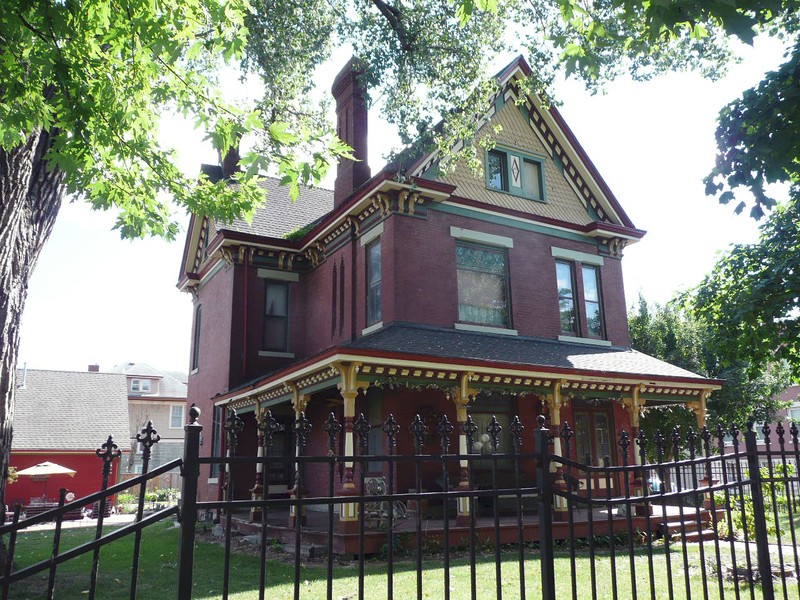William Francis Shelley House
Introduction
Text-to-speech Audio
Built from 1887 to 1889, this historic home is one of the oldest in the area and predates Kansas City's annexation of Hyde Park. When the home was constructed, the planning of the Hyde Park neighborhood included stipulations that no businesses were to operate in the neighborhood and homes must exceed $15,000 (equal to more than $400,000 in 2021). While the neighborhood was only open to residents with healthy financial means, it has changed over time similar to other neighborhoods that were once on the periphery of a city center. The home's first owner William Shelley held many jobs in the city and his family was close to many of the era's most influential people, including Civil War General William Tecumseh Sherman. George Shelley, the brother of William, twice served as the city mayor during the late 1880s.
Images
William Francis Shelley House

Backstory and Context
Text-to-speech Audio
The William F. Shelley residence is typical of homes found in the fashionable and up-and-coming 19th century Kansas City neighborhood of Hyde Park. Built between 1887 and 1889, the Shelly Residence survives as one of the oldest original remaining residences erected in Hyde Park. The house, designed in the local "Builder's Vernacular" style, comprises several stylistic influences, including Italianate and Queen Anne elements.
The planning of Hyde Park, originally part of Westport before Kansas City annexed the neighborhood in 1897, included a stipulation that neither businesses nor houses less than $15,000 (roughly equal to $420,000 in 2021 ) were built in the community. In essence, Hyde Park catered to the wealthy. Hyde Park emerged during an 1880s land boom when speculation drove up land prices. But, the bottom dropped out after 1888, just as Shelley finished the now-historic house. As a result, less than 50 houses stood in Hyde Park by 1900. Finally, in 1907, the housing market recovered, and the number of homes In Hyde Park increased fivefold, with the bulk of the houses erected during the economic boom of the 1920s. Because the Shelley house emerged early in Hyde Park's development, it arrived before the $15,000 stipulations were implemented; the home only cost $11,000 to construct (around $310,000 in 2021).
Mr. William Francis Shelley ( ~1845 - 1913) was born in Keokuk, Iowa, but left Iowa to attend Princeton University, where he graduated in 1865. Mr. Shelley married Leonara Williamson (1850-1923), from Memphis, Tennessee, on August 11, 1876. He and Mrs. Shelley took a two-year-long honeymoon abroad. In the year before their wedding, Union General William Tecumseh Sherman, a friend of the Williamson family, provided the newlyweds with several letters of introduction. In 1875 Mrs. Shelley was presented to Queen Victoria of Great Britain and Prime Minister Disraeli.
The couple moved to Kansas in 1886, and William began work as treasurer for the JarvisConklin Mortgage Trust Company one year later, in 1887. But, Shelley rarely stayed at one job very long. From 1887 to 1912, he worked in several positions:
- 1887-1889: Treasurer, Jarvis-Conklin Mortgage Trust Company
- 1891-1892: Private Broker
- 1893-1898: Auditor at Swift & Company
- 1899: Cashier for Joseph Schlitz Brewing Company
- 1900-1901: Private Accountant
- 1902: Bookkeeper for Taggart Grocery Store
- 1903: Bookkeeper for Burd and Fletcher Painting Company!
- 1904-1912: Accountant for George Peake and Son
It was during Shelley's first job that the house was built in Kansas City, Missouri. He and his wife went on to have three children; they all lived in the historic home for many years. The house design incorporates several architectural styles, making it part of the loosely defined vernacular design. In essence, a vernacular house is built using what was available to them (local materials, local influences) and includes various design elements that, in some cases, allow a structure to become distinct to a specific area.
The Shelley house stands as an early example of the development of Hyde Park before Kansas City annexed the area. Although the house's architecture and size demonstrate that it served a family with healthy financial means, homes built in the neighborhood after the Shelley House were more prominent and expensive. Still, the home provides insight into the Hyde Park community during the 1880s and 1890s; it was purely residential and catered to the upper-middle-class.
Cite This Entry
Admin, Clio and Mathew Powers. "William Francis Shelley House." Clio: Your Guide to History. August 6, 2021. Accessed March 26, 2025. https://theclio.com/tour/2016/5
Sources
Becker, Linda F. "Nomination form: Shelley, William Francis, House." National Register of Historic Places. archives.gov. https://catalog.archives.gov/OpaAPI/media/63819228/content/electronic-records/rg-079/NPS_MO/78001662.pdf
Hyde Park Neighborhood Association. "About Hyde Park: Kansas City's Historic Hyde Park." hydeparkkc.org. Accessed August 2, 2021. https://hydeparkkc.org/about-hyde-park/.
Thomann, Lauren. "What Is Vernacular Architecture?" The Spruce. 12/17/20. https://www.thespruce.com/vernacular-architecture-4801653.
By Mwkruse - Own work, CC BY-SA 3.0, https://commons.wikimedia.org/w/index.php?curid=42300033

